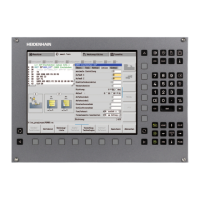January 2012 1.3 NC Software 548 328-04 59
New: Rear-face machining with opposing spindle
The following functions have been added to the control so that it can
support rear-face machining with opposing spindle:
• Dashboard display for rear-face machining
The new dashboard element can be used to show the status of rear-
face machining and the current zero-point shift (See "Overview of the
available dashboard elements" on page 1296).
• New: MMI supports rear-face machining with opposing spindle
The parameter WP (active workpiece spindle) was added to the input
cycles for teach-in and manual operation, in order to support rear-face
machining with opposing spindle. The current workpiece spindle is
entered in the cycles as a proposed value when making a new entry.
The setup functions also include the active workpiece spindle and can
thus also be used on the main or opposing spindle. Refer to the User's
Manual for your control for more information about this.
• New: Simulation supports rear-face contours
The simulation now also supports the display of rear-face contours. In
addition, in the smart.Turn editor the current contour of the workpiece
blank and the finished part can be saved and reloaded for rear-face
machining. Refer to the User's Manual for your control for more
information about this.
• New: ICP editor supports rear-face contours
The ICP editor now also supports the editing of rear-face contours.
Refer to the User's Manual for your control for more information about
this.
• New: Activating kinematics for rear-face machining (G30)
The G function G30 is now available for activation of the kinematics for
rear-face machining (See "Kinematic models for rear-side machining" on
page 1458).
New: Spindle synchronization (G720)
The spindle synchronization option synchronizes the shaft speeds of two or
more spindles so that they rotate synchronously, with a gear ratio or a
defined offset. The synchronism can be used to transfer the workpiece
between the main spindle and the opposing spindle, or for special
machining tasks such as polygonal turning (manufacture of key flats without
time-consuming milling) or hobbing. Refer to the User's Manual for your
control for more information about this.
New: Saving the offset angle for spindle synchronization (G905)
The G905 function can be used to store the offset angle of main and
opposing spindles during spindle synchronization, and take it into account
for a zero-point shift in the C axis (G152). Refer to the User's Manual for your
control for more information about this.
New: Traversing to a dead stop (G916)
The "traverse to a fixed stop" function (G916) is now available for transferring
the workpiece to the second traversable spindle or for pressing the tailstock
against the workpiece. To do this, the control moves up to the fixed stop and
stops as soon as the servo lag has been reached. Then the position of the
fixed stop is saved and the remaining path of traverse is deleted. The
contact force at the stop position can be programmed (See "Traversing to a
fixed stop (G916) and sleeve monitoring (G930)" on page 1464).

